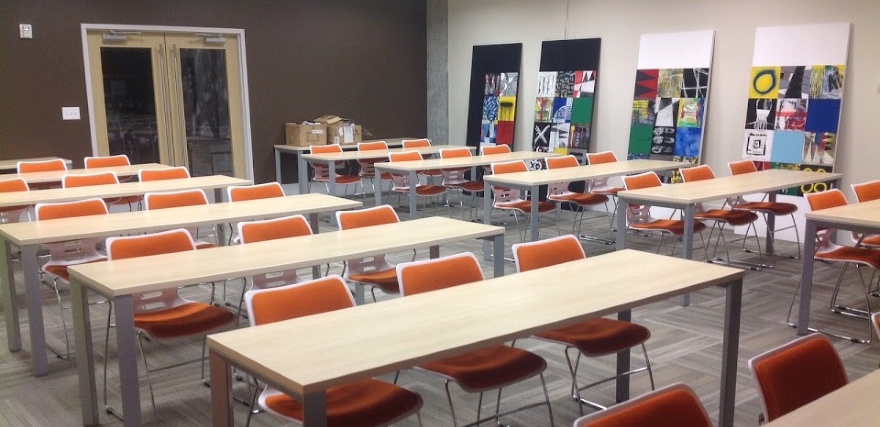Recently, we had the opportunity to hear from a number of our district colleagues about what our conference facility needed in order to further align with their learning wants and needs. As a regional educational service agency, we always look to partner with districts to design the best professional learning possible, and a key component of that is tied to the learning space itself.
Space is a funky thing. It never is the only determinant in whether our learning sticks or not, yet it is an important one. The mindset we are in when we engage in a learning opportunity can greatly influence what we take from the experience when we leave. And, at least a portion of that mindset is determined by the space itself.
There were a number of recommendations that were made by our district colleagues, and I’m proud to say my agency is working to address the feedback in ways that will further cultivate a space that encourages and accentuates the learning process. Here are three recommendations that we are currently addressing, and that make a lot of sense for furthering learning.
Make it colorful. A number of years ago we remodeled our conference facility. We pulled up carpet and put down laminate, we adjusted technology available in all the conference spaces, we redesigned the layout of a number of the conference rooms, and we purchased new furniture (among other things). What we also did was make every wall a neutral color. This was done because we wanted to showcase a bright open space that was clean and polished. We ended up getting that bright, clean, and polished feel, and we also ended up getting feedback that it felt bland, sterile, and too basic. Color can make a tremendous difference regarding how we feel about the space we are in. Whether we use muted tones or bright colors, even a small bit of color can make a difference in how we engage. And color brings personality by recognizing that while one neutral color may speak to constancy, it doesn’t speak to the varied nature of learning.
Let pictures and work tell a story. In the past, we had placed pictures of students from across our region on the walls of our conference center. The pictures were fantastic and led to smiles and conversation whenever educators walked through the halls. And the pictures also got older. After a few years, as exhibited by clothing, environment, and more, it was clear that the pictures were no longer up-to-date. So when we remodeled, we removed them. And the feedback we received asked us to put them back. Along with new pictures of learners and learning, educators also mentioned they would love to see samples of student work from across our districts. This combination of visuals of the learning process combined with artifacts and products of learning speak to an environment that welcomes the challenges of engaging in learning as well as the outcomes. When we see others learning and see what they have accomplished, we are more likely to put ourselves in that same mental state. We are excited to explore ways to honor and showcase the great work that is happening across our schools and districts.
Give people what they need. We’ve always made sure that we let our educators leading workshops know what materials we can provide, and what materials we expect learning facilitators to provide. This has worked well, and the openness of these conversations allows for workshops and institutes to take place with very few logistical hurdles. Our experience shows that if our facilitators are prepared, then learning can best happen. One additional learning that we’ve gained, both from feedback from workshop participants, and our own staff, has been the importance of having materials easily accessible within the conference rooms themselves. So, we’re building “workshop boxes” for facilitators that will be continuously replenished and that can be taken from our reception desk directly to our conference rooms. Our agency will take care of refilling all materials with the understanding that facilitators will return them when they finish for the day. This accomplishes a number of goals. First, rather than having facilitators work individually with whoever they set up the workshop with, all boxes, for all rooms, will contain all the same highly-requested materials. This streamlines the process, reduces concerns for facilitators, and guarantees that learners will have the best possible experience. Second, these boxes allow us to move from a “here’s what we can provide and here’s what we can’t” to a uniform supplying of materials that are based on regular requests. While we still anticipate that some folks will need to bring their own materials, we’re making it easier for everyone to get what they need, regardless of where they are in our building.
So, whether it is about adding personality and emotion, showing learning in action, and/or making it easy and efficient for learning to happen, we are on a constant quest to make sure that the learning spaces within our agency promote learning mindsets in those who join us. The best part? That our journey is continually informed by those we serve, and that the combined feedback and actions taken will allow us to more effectively design space for a learning mindset now and into the future.
Fred Ende is the assistant director of Curriculum and Instructional Services for Putnam/Northern Westchester BOCES in Yorktown Heights, N.Y. Fred blogs at www.fredende.blogspot.com, Edutopia, ASCD EDge and SmartBrief Education. His book, Professional Development That Sticks, is available from ASCD. Visit his website www.fredende.com. Find him on Twitter @fredende.
___________________________________
Like this article? Sign up for ASCD SmartBrief to get news like this in your inbox, or check out all of SmartBrief’s education newsletters, covering career and technical education, educational leadership, math education and more.
